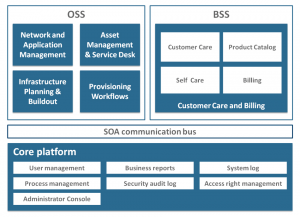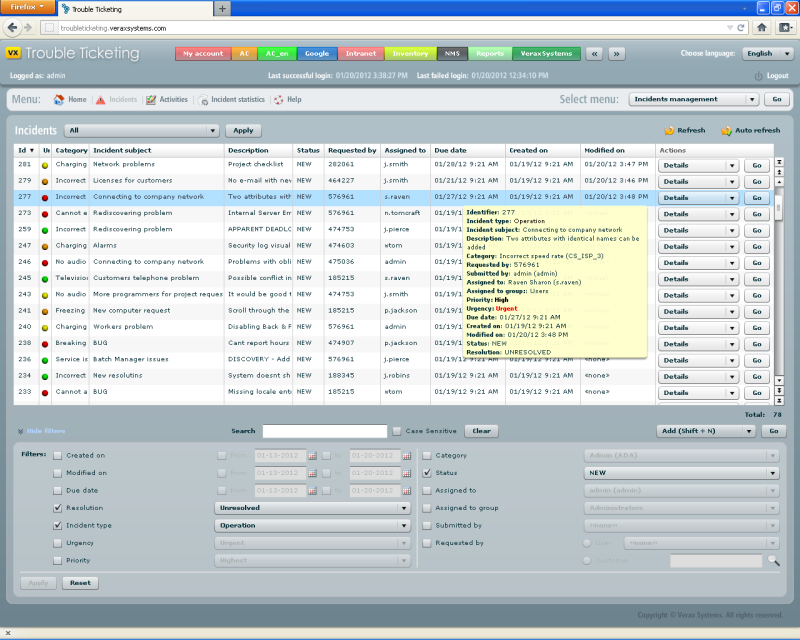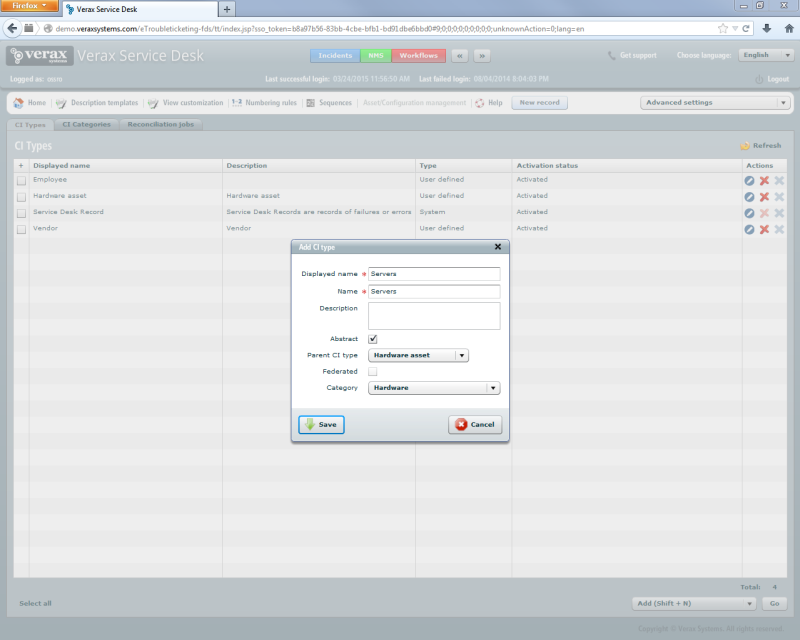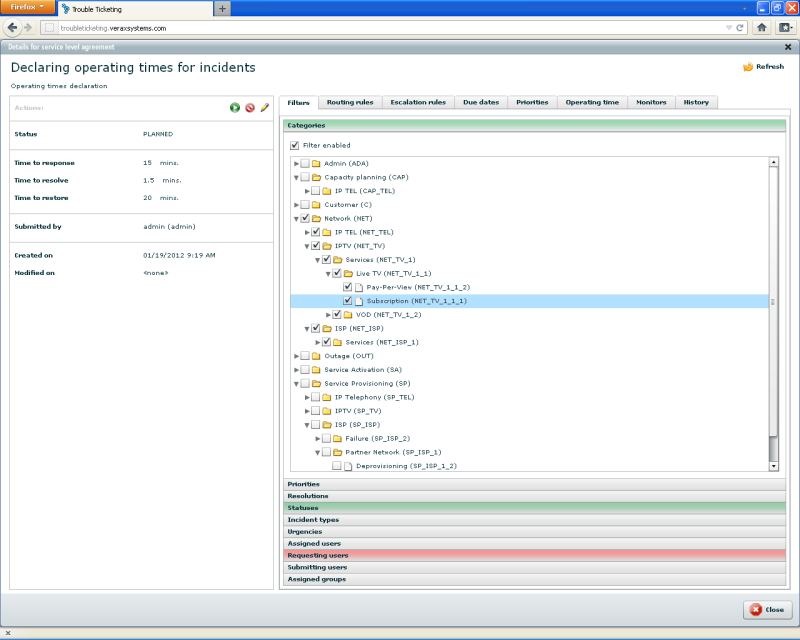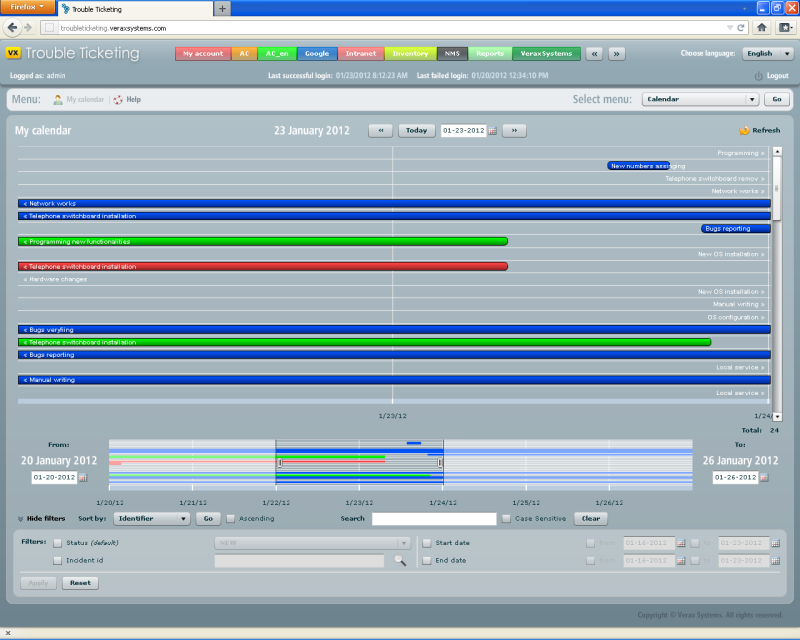Asset Management & Service Desk
Verax Asset Management & Service Desk integrates IT asset management with service desk processes in order to reduce operations cost and increase customer satisfaction by ensuring timely and consistent service request resolution.
- Tracking of internally- and customer- reported incidents in a single, centralized location.
- Detailed incident information, including:
- Description, status, reported comments, etc.
- Notes, categories, priority & urgency.
- Attachments (screen shots, documents, videos and others).
- User-configurable templates for commonly used incident descriptions (user can pick a predefined description for increased productivity).
- “Blocked by” and “Dependent on” lists for proper prioritization of incidents.
- User-configurable incident categories (e.g. network, application, etc.) with team assigning and task scheduling.
- Configurable incident lifecycle and statuses that reflect support & service processes and procedures in any organization.
- Intelligent, automatic incident dispatch.
- Automation of service requests management (routing rules, escalation rules and priorities).
- Security and access permissions (access control to incident information through a system of user groups and permissions).
- History tracking and incident history retention.
- Configurable, e-mail based notification manager for new incidents, status changes and others.
- Ability to turn notifications on/off for a single incident.
- Numbering rules for generating incident and change request identifiers:
- Multiple, user-configurable rules with firing order,
- Category and/or customer information matching (i.e. a different numbering schema may apply for tickets generated by different customers),
- Configurable numbering sequences with start and increment values,
- Configurable identifier format based on customer or category information (e.g. CUST-CRI-005).
- Hardware inventory management: servers, hosts, storage systems, memory, network interfaces and others.
- Software inventory management: Operating systems, firmware updates, software information such as publisher, version, and installation date and others.
- CMDB synchronization with Verax NMS & APM inventory for CIs (configuration items) like hosts, routers, interface, CPUs and others that are present in the NMS inventory.
- Asset audit: full history log including information about service requests, reported incidents, etc.
- User-defined fields for extending and customizing assets’ description.
- Relationship management: one to many, many to one, many to many.
- Integration Adapter tool for importing data to CMDB from:
-
- SQL databases: Oracle, Microsoft SQL Server, MySQL and PostgreSQL (via SQL queries)
- Comma Separated Values (CSV) files
- XML files
- Other, custom sources via user-defined readers (requires Java coding)
- Rapid SLA definition via an easy to use GUI.
- End-to-end incident management.
- Routing Rules: assigning service requests to specific users or groups.
- Escalation Rules: sets of rules specifying actions that are taken automatically, e.g. when a service request has not been resolved by its due date.
- Priorities (priorities of service requests based on predefined parameters).
- Time tracking with online progress control.
- Due dates (ability to set up various due dates and resolution times depending on service types).
- Tracking of internally or customer requested change requests (such as configuration changes, planned maintenance works, etc.) in a single, centralized location.
- Detailed change request information, including:
- Description, status, reported comments, etc.
- Notes, categories, priority & urgency.
- Attachments.
- Assigning responsible persons.
- Visualization of change requests in the calendar view.
- Instant access to tips and solutions on how to resolve common issues.
- Quick and simple creation of new knowledge base items with user friendly WYSIWYG editor.
- Rich content (ability to attach files, images, videos and others).
- Improved team performance via effective information sharing and knowledge retention.
- Generation of reports in PDF, CSV or XLS formats.
- Graphically designed report templates.
- Scheduled report generation times (e.g. every Friday at 5PM).
- Configurable report retention times.
- Automatic report distribution via email to configured user groups.
- Support for passing parameters to generated reports such as device lists, time ranges, etc.
- Security profiles associated with each user defining: password strengths, session timeouts, idle timeouts and others.
- Access to data (e.g. incidents in particular categories) limited on a per user group basis.
- Security audit log providing full information on user logins (timestamp, host IP address, success, failure), logouts and denied operations with a graphical interface.
- Event log for tracing system and user events (e.g. new object added, object deleted, etc.).
- Logging & tracing services configurable at runtime.
- Secure communications bus between client and server, ensuring that all exchanged data is encrypted.
- Easy installation and configuration: no coding/scripting knowledge required.
- Customizable look and feel.
- User friendly, rich GUI based on Rich Internet Application technology.
- Support for full screen mode, high-resolutions, multiple displays and panel hiding – ready to be deployed at Network Operations Centers (NOCs).
- Advanced filtering capabilities with named filter saving, multiple filter criteria, multiple values in filter criteria and others.
- Data export to CSV files.
- Efficient hyperlink-driven navigation for maximum operator productivity.
- Online, contextual help system.
- Multilingual user interface changeable at runtime.
- Filters, incremental search, mini-dashboards, statistics in each main view for maximum operator productivity.
- System log and configurable tracing levels for easy troubleshooting and support.
- Flexibility of configuration:
- Configurable incident and change request views.
- Configurable priorities and urgencies (color definition, values).
- Open for integration and SOA-ready via open SOAP/RMI interfaces.
- Out-of-the-box integration with the Verax NMS & APM and
Customer Care & Billing.
System requirements
Open source: Linux and Open Solaris.
CPU: Dual-core running at 2 GHz.
RAM: 1 GB of free, available RAM for NMS & APM, additional 1 GB when the database is running on the same host.
Disk space: 1 GB for NMS & APM, additional 3 GB (4 GB total) when the database is running on the same host.
Any mail server supporting POP3 or IMAP (optional, required only for incident reporting via e-mail).
Commercial: Oracle (version 10 or higher), Microsoft SQL Server (2008 or higher).
Free: Oracle Express, Microsoft SQL Server Express.
Verax Asset Management & Service Desk runs on any web browser supporting Adobe Flash technology version 9 or higher, such as: Internet Explorer, Firefox, Chrome, Opera, Safari and others.



